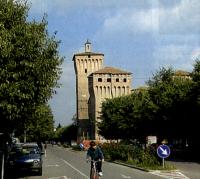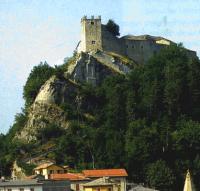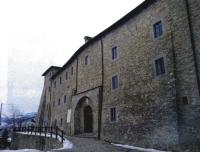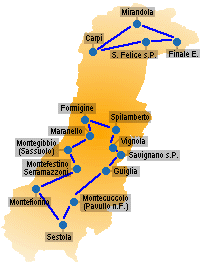The castles of the Po Plain
The castles of the Po Plain, built for
defensive purposes during the centuries when struggles between
families, towns or overlords made fortresses capable of withstanding
enemy attacks a necessity, have generally undergone a great deal
of reworking in later, less violent periods when comfortable residential
accommodation became the top priority. Even more recently, some
have become Town Halls and others museums, while a few are still
the private property of ancient families. The castles of Spilamberto,
Vignola and Savignano are to the south of Modena,
along the line of the via Vignolese; although they were all built
to defend Panaro river crossings against attack from the Bologna
side, Vignola castle is the best preserved and most architecturally
impressive of the three. Its massive central body (with a projecting
rampart supported by corbels on all sides), with its tall corner
towers, is in typical XIV Century style. The name of the tallest
tower, known as the Nonantola tower, reminds us that the fortress
used to belong to the Abbey of Nonantola. However, the fundamental
structure of the castle (now a museum) that has survived to the
present day was created by the Contrari family, feudal vassals
of the Este Dukes of Modena, who lived there at the beginning
of the XV Century. The rampart walk gives an impressive view
over the Panaro valley. The castles of Formigine (now the Town
Hall) and Maranello (private property) lie along the via Giardini
between Modena and the mountains, while Carpi, on the plain to
the North of the city, has a large castle which now belongs to
the municipality.
 Carpi castle is actually a combination
of a large number of towers, fortresses, turrets and keeps built
at different times between 1312 and 1520, the oldest of which,
the tower with Ghibelline merlons known as the Torre del Passerino,
is the work of the Bonaccolsi family. The two centuries which
followed saw the addition of the Rocca Nuova, the splendid residence
of the Pio family, the Rocca di Marsilio and the Rocca Antica
keeps, and finally the Torrione di Galasso, with its ornamental
turrets. The entire complex was transformed and embellished by
Prince Alberto III Pio, who combined the previous keeps and constructed
the elegant facade, to which the clock tower was added at a later
date. The castle is in a dominant position, overlooking one of
Italy's largest squares. The flat lands running towards the
Po river also have other castles worthy of note. Finale Emilia
contains the "Castello delle rocche", rebuilt by the
Este family in the XV Century and then further modified by them
for use as a residence. It now belongs to the municipality.
Its four-sided ground plan with three corner towers and a donjon
is duly imposing and some structural and decorative elements can
still be traced, including the dovetail merlons and the postern
with the impost which used to support the drawbridge. At S.
Felice sul Panaro the castle is again in brick with corner
towers, but its modern role is quite different, as it has been
restored to serve as the Town Hall and library. The only reason
for interest in Mirandola castle is the fame of its former
masters, the Pico family, since only a few remains of the fortress
have survived (the Palazzo Comunale is an imitation built in Medieval
style).
Carpi castle is actually a combination
of a large number of towers, fortresses, turrets and keeps built
at different times between 1312 and 1520, the oldest of which,
the tower with Ghibelline merlons known as the Torre del Passerino,
is the work of the Bonaccolsi family. The two centuries which
followed saw the addition of the Rocca Nuova, the splendid residence
of the Pio family, the Rocca di Marsilio and the Rocca Antica
keeps, and finally the Torrione di Galasso, with its ornamental
turrets. The entire complex was transformed and embellished by
Prince Alberto III Pio, who combined the previous keeps and constructed
the elegant facade, to which the clock tower was added at a later
date. The castle is in a dominant position, overlooking one of
Italy's largest squares. The flat lands running towards the
Po river also have other castles worthy of note. Finale Emilia
contains the "Castello delle rocche", rebuilt by the
Este family in the XV Century and then further modified by them
for use as a residence. It now belongs to the municipality.
Its four-sided ground plan with three corner towers and a donjon
is duly imposing and some structural and decorative elements can
still be traced, including the dovetail merlons and the postern
with the impost which used to support the drawbridge. At S.
Felice sul Panaro the castle is again in brick with corner
towers, but its modern role is quite different, as it has been
restored to serve as the Town Hall and library. The only reason
for interest in Mirandola castle is the fame of its former
masters, the Pico family, since only a few remains of the fortress
have survived (the Palazzo Comunale is an imitation built in Medieval
style).
Castles in the Mountains
 There are many castles, built as solid
fortresses in dominant positions, in the Modena Apennines, and
there would be even more of them if we were also to consider smaller
defensive structures such as towers and "tower-houses",
which reflect a history of local struggles and continuous unrest.
We will limit our survey to the most important, best preserved
castles. That of Guiglia, in a defensive position overlooking
the Panaro valley, is now a hotel. Monfestino castle in
the Frignano region is private property, so only the outside can
be seen, but the battlements protecting the main entry and a circular
tower connected to the walls are in clear view. Montecuccolo
is a castle with fortified hamlet; the keep and the rampart walk
were restored in the 1980s, in work which attracted criticism
because of the use of modern materials such as glass on Medieval
structures.
There are many castles, built as solid
fortresses in dominant positions, in the Modena Apennines, and
there would be even more of them if we were also to consider smaller
defensive structures such as towers and "tower-houses",
which reflect a history of local struggles and continuous unrest.
We will limit our survey to the most important, best preserved
castles. That of Guiglia, in a defensive position overlooking
the Panaro valley, is now a hotel. Monfestino castle in
the Frignano region is private property, so only the outside can
be seen, but the battlements protecting the main entry and a circular
tower connected to the walls are in clear view. Montecuccolo
is a castle with fortified hamlet; the keep and the rampart walk
were restored in the 1980s, in work which attracted criticism
because of the use of modern materials such as glass on Medieval
structures.
 Sestola has a sturdy fortress strategically
sited above a sheer cliff, reached by a staircase, which offers
an attractive view of the town. Near Sassuolo, Montegibbio
castle belongs to a consortium of local authorities, who have
opened its large park with beautiful old trees to the public.
Rebuilt as a residence after the ravages of an earthquake in
1501 and centuries of war, it stands on a hilltop which has been
fortified since the X Century at least. The castle at Montefiorino,
in the Val Dragone, was originally constructed in the XIII Century
by the Montecuccoli family; it has now been renovated as the Town
Hall and also as the Museum of the Partisan Republic of Montefiorino.
The ancient keep, with traces of a doorway on the second floor,
still dominates the restored inner courtyard.
Sestola has a sturdy fortress strategically
sited above a sheer cliff, reached by a staircase, which offers
an attractive view of the town. Near Sassuolo, Montegibbio
castle belongs to a consortium of local authorities, who have
opened its large park with beautiful old trees to the public.
Rebuilt as a residence after the ravages of an earthquake in
1501 and centuries of war, it stands on a hilltop which has been
fortified since the X Century at least. The castle at Montefiorino,
in the Val Dragone, was originally constructed in the XIII Century
by the Montecuccoli family; it has now been renovated as the Town
Hall and also as the Museum of the Partisan Republic of Montefiorino.
The ancient keep, with traces of a doorway on the second floor,
still dominates the restored inner courtyard.

 Carpi castle is actually a combination
of a large number of towers, fortresses, turrets and keeps built
at different times between 1312 and 1520, the oldest of which,
the tower with Ghibelline merlons known as the Torre del Passerino,
is the work of the Bonaccolsi family. The two centuries which
followed saw the addition of the Rocca Nuova, the splendid residence
of the Pio family, the Rocca di Marsilio and the Rocca Antica
keeps, and finally the Torrione di Galasso, with its ornamental
turrets. The entire complex was transformed and embellished by
Prince Alberto III Pio, who combined the previous keeps and constructed
the elegant facade, to which the clock tower was added at a later
date. The castle is in a dominant position, overlooking one of
Italy's largest squares. The flat lands running towards the
Po river also have other castles worthy of note. Finale Emilia
contains the "Castello delle rocche", rebuilt by the
Este family in the XV Century and then further modified by them
for use as a residence. It now belongs to the municipality.
Its four-sided ground plan with three corner towers and a donjon
is duly imposing and some structural and decorative elements can
still be traced, including the dovetail merlons and the postern
with the impost which used to support the drawbridge. At S.
Felice sul Panaro the castle is again in brick with corner
towers, but its modern role is quite different, as it has been
restored to serve as the Town Hall and library. The only reason
for interest in Mirandola castle is the fame of its former
masters, the Pico family, since only a few remains of the fortress
have survived (the Palazzo Comunale is an imitation built in Medieval
style).
Carpi castle is actually a combination
of a large number of towers, fortresses, turrets and keeps built
at different times between 1312 and 1520, the oldest of which,
the tower with Ghibelline merlons known as the Torre del Passerino,
is the work of the Bonaccolsi family. The two centuries which
followed saw the addition of the Rocca Nuova, the splendid residence
of the Pio family, the Rocca di Marsilio and the Rocca Antica
keeps, and finally the Torrione di Galasso, with its ornamental
turrets. The entire complex was transformed and embellished by
Prince Alberto III Pio, who combined the previous keeps and constructed
the elegant facade, to which the clock tower was added at a later
date. The castle is in a dominant position, overlooking one of
Italy's largest squares. The flat lands running towards the
Po river also have other castles worthy of note. Finale Emilia
contains the "Castello delle rocche", rebuilt by the
Este family in the XV Century and then further modified by them
for use as a residence. It now belongs to the municipality.
Its four-sided ground plan with three corner towers and a donjon
is duly imposing and some structural and decorative elements can
still be traced, including the dovetail merlons and the postern
with the impost which used to support the drawbridge. At S.
Felice sul Panaro the castle is again in brick with corner
towers, but its modern role is quite different, as it has been
restored to serve as the Town Hall and library. The only reason
for interest in Mirandola castle is the fame of its former
masters, the Pico family, since only a few remains of the fortress
have survived (the Palazzo Comunale is an imitation built in Medieval
style).
 There are many castles, built as solid
fortresses in dominant positions, in the Modena Apennines, and
there would be even more of them if we were also to consider smaller
defensive structures such as towers and "tower-houses",
which reflect a history of local struggles and continuous unrest.
We will limit our survey to the most important, best preserved
castles. That of Guiglia, in a defensive position overlooking
the Panaro valley, is now a hotel. Monfestino castle in
the Frignano region is private property, so only the outside can
be seen, but the battlements protecting the main entry and a circular
tower connected to the walls are in clear view. Montecuccolo
is a castle with fortified hamlet; the keep and the rampart walk
were restored in the 1980s, in work which attracted criticism
because of the use of modern materials such as glass on Medieval
structures.
There are many castles, built as solid
fortresses in dominant positions, in the Modena Apennines, and
there would be even more of them if we were also to consider smaller
defensive structures such as towers and "tower-houses",
which reflect a history of local struggles and continuous unrest.
We will limit our survey to the most important, best preserved
castles. That of Guiglia, in a defensive position overlooking
the Panaro valley, is now a hotel. Monfestino castle in
the Frignano region is private property, so only the outside can
be seen, but the battlements protecting the main entry and a circular
tower connected to the walls are in clear view. Montecuccolo
is a castle with fortified hamlet; the keep and the rampart walk
were restored in the 1980s, in work which attracted criticism
because of the use of modern materials such as glass on Medieval
structures.
 Sestola has a sturdy fortress strategically
sited above a sheer cliff, reached by a staircase, which offers
an attractive view of the town. Near Sassuolo, Montegibbio
castle belongs to a consortium of local authorities, who have
opened its large park with beautiful old trees to the public.
Rebuilt as a residence after the ravages of an earthquake in
1501 and centuries of war, it stands on a hilltop which has been
fortified since the X Century at least. The castle at Montefiorino,
in the Val Dragone, was originally constructed in the XIII Century
by the Montecuccoli family; it has now been renovated as the Town
Hall and also as the Museum of the Partisan Republic of Montefiorino.
The ancient keep, with traces of a doorway on the second floor,
still dominates the restored inner courtyard.
Sestola has a sturdy fortress strategically
sited above a sheer cliff, reached by a staircase, which offers
an attractive view of the town. Near Sassuolo, Montegibbio
castle belongs to a consortium of local authorities, who have
opened its large park with beautiful old trees to the public.
Rebuilt as a residence after the ravages of an earthquake in
1501 and centuries of war, it stands on a hilltop which has been
fortified since the X Century at least. The castle at Montefiorino,
in the Val Dragone, was originally constructed in the XIII Century
by the Montecuccoli family; it has now been renovated as the Town
Hall and also as the Museum of the Partisan Republic of Montefiorino.
The ancient keep, with traces of a doorway on the second floor,
still dominates the restored inner courtyard.